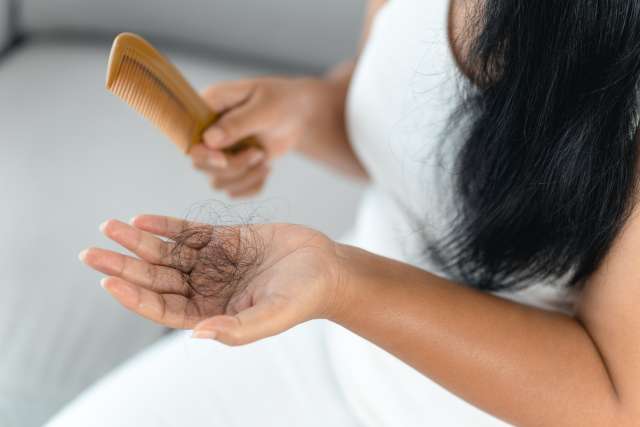Men get most of the attention when it comes to hair loss. But it’s incredibly common in women as well. By age 50, up to 40% of women will have noticeable hair loss, but it can happen at any age.
Thinning hair typically looks different on women than men. Rather than a specific bald patch or receding hairline, women might notice that their part looks wider, or that their ponytail is suddenly thinner.
The life cycle of your hair
Hair grows in cycles, so we usually have new strands growing to replace the ones that are ready to fall out. The three phases of hair growth are:
- Anagen phase: At any time, about 90% percent of the hair on your head is in this growth phase. The anagen phase lasts between 2 and 8 years.
- Catagen phase: This is the transition phase, which lasts 2 to 3 weeks. Hair follicles shrink and hair stops growing.
- Telogen phase: This resting phase lasts from 2 to 4 months. At the end of it, those strands fall out.
Seeing hair in the shower drain or hairbrush, doesn’t necessarily mean you have a problem. It’s normal to lose between 50 and 100 strands of hair each day. But if you suddenly notice more strands falling out or see visible areas of thinning hair, you should talk to your doctor.
Causes of hair loss in women
Sudden and dramatic hair loss can happen because of taking specific medications (such as those used during chemotherapy). In some cases, rapid hair loss can occur during a period of high stress or trauma to the body.
That type of hair loss is called telogen effluvium because hair in the anagen (or growing) phase switches to the telogen (resting) phase. Fewer new strands grow and more begin to fall out — up to 300 per day.
Common causes of telogen effluvium include:
- Childbirth
- Severe infection or high fever
- Crash diets that are too low in calories and protein
- Iron deficiency
- Vitamin D deficiency
- Psychological stress, depression or anxiety
- Thyroid disease
The most common type of hair loss in women is a condition called female pattern hair loss (FPHL), also known as androgenetic alopecia. It affects up to 30 million women in the U.S. — most of them in their 40s, 50s or 60s.
Just like male pattern baldness, FPHL is an inherited condition. If your mother or father suffered from hair loss, you may inherit the genes that cause it.
FPHL tends to become more common after menopause. That means there is likely also a hormonal component to the condition. Levels of estrogen drop dramatically around menopause. This may be partly to blame for the hair follicles shrinking. As the hair follicles continue to shrink, new strands eventually stop growing.
Hormonal shifts may also explain why women who suffer from polycystic ovarian syndrome (PCOS) often experience female pattern hair loss at younger ages. Women with PCOS experience an overproduction of androgens — male hormones, such as testosterone. Those hormones can lead to thinning hair.
Hair loss treatments for women
The good news is that there are effective treatments for women experiencing hair loss. From over-the-counter topical therapies to prescription medications or in-office procedures, you have lots of good options, including:
- Topical minoxidil: This drug is available over the counter in 2% and 5% strengths. It’s approved by the Food and Drug Administration for both male and female pattern baldness and is meant to be applied to the scalp daily.
- Low-light lasers: There are laser combs and caps that use low-energy light to stimulate hair follicles. While there are several types on the market, only a few have earned FDA approval.
- Prescription oral medications: Finasteride and spironolactone are both FDA-approved medications — but neither is approved specifically for female pattern hair loss. Some dermatologists use them off-label to treat hair loss.
- Platelet-rich plasma: This treatment involves taking plasma from your blood and injecting into your scalp. While it is FDA-approved for orthopedic uses (to help heal injured tendons and ligaments), it’s not specifically approved for hair regrowth.
- Microneedling: This treatment is often used along with topical minoxidil. The doctor uses fine needles to make tiny holes in the scalp, then applies the topical treatment.
If you’re concerned about hair loss, talk to your doctor. They can help diagnose what might be causing it and offer treatment options to help manage it.



